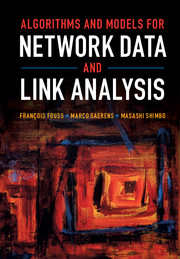Book contents
- Frontmatter
- Contents
- List of Algorithms
- List of Symbols and Notation
- Preface
- 1 Preliminaries and Notation
- 2 Similarity/Proximity Measures between Nodes
- 3 Families of Dissimilarity between Nodes
- 4 Centrality Measures on Nodes and Edges
- 5 Identifying Prestigious Nodes
- 6 Labeling Nodes: Within-Network Classification
- 7 Clustering Nodes
- 8 Finding Dense Regions
- 9 Bipartite Graph Analysis
- 10 Graph Embedding
- Bibliography
- Index
5 - Identifying Prestigious Nodes
Published online by Cambridge University Press: 05 July 2016
- Frontmatter
- Contents
- List of Algorithms
- List of Symbols and Notation
- Preface
- 1 Preliminaries and Notation
- 2 Similarity/Proximity Measures between Nodes
- 3 Families of Dissimilarity between Nodes
- 4 Centrality Measures on Nodes and Edges
- 5 Identifying Prestigious Nodes
- 6 Labeling Nodes: Within-Network Classification
- 7 Clustering Nodes
- 8 Finding Dense Regions
- 9 Bipartite Graph Analysis
- 10 Graph Embedding
- Bibliography
- Index
Summary
Introduction
Many different measures of prestige and centrality of a node have been defined in social science, computer science, physics, and applied mathematics. Some authors call these measures “importance,” “standing,” “prominence,” or “popularity,” especially in the case of social networks. In this book, when the graph is directed, we speak about prestige and importance (they are used interchangeably), whereas in the case of an undirected graph, the concept is called centrality.
We therefore assume in this chapter that the elements, or weights, aij, of the adjacency matrix can be interpreted as a volume of endorsement, faith, credit, or citation, from object i to object j – this could be the number of references from i to j, the degree of confidence i has in j, and so on. Moreover, the graph is assumed to be directed, leading to a nonsymmetric adjacency matrix.
In some situations, though, we encounter the case where the weights on the arcs represent the amount of “influence” or “dominance” a node i has on node j, instead of endorsement. In this situation, the graph containing the reversed directed links (and whose adjacency matrix is thus AT) can be interpreted as a new graph whose links represent some kind of endorsement. Indeed, if the links i → j model a relation of the type “i influences j,” the reverse relation j → i can usually be interpreted as “j gives credit to i.” Thus, if a graph is representing an influence relation, it usually suffices to transpose its adjacency matrix to recover a endorsement-like relation. This shows that we must of course be careful about the meaning of the relation between nodes defining G, which should be clearly defined and interpreted.
In summary, this chapter is concerned with prestige measures (i.e., scores, or ratings) quantifying the importance of a node in a directed graph whose edges carry some “endorsement” relation. In this context, the prestige of a node increases as it becomes the object of more positive citations or endorsements (incoming links) [804]. Numerous measures were developed in the social sciences, only the most popular ones being introduced in this chapter. For other such measures and more details about the discussed measures, the interested readers are advised to consult, for example, reference [804].
- Type
- Chapter
- Information
- Algorithms and Models for Network Data and Link Analysis , pp. 201 - 234Publisher: Cambridge University PressPrint publication year: 2016



